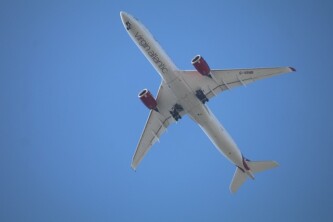The first transatlantic flight powered entirely by alternative fuels has taken off from London’s Heathrow airport. This groundbreaking flight is seen as a demonstration by airlines that a greener way of flying is possible. However, one of the challenges that still remains is the lack of a consistent supply of alternative fuels.
The flight marks an important milestone in the aviation industry’s efforts to reduce its carbon footprint and combat climate change. By using 100% green fuels, the flight aims to show that it is possible to fly long distances without relying on traditional fossil fuels.
Alternative fuels, such as biofuels made from sustainable sources, have the potential to significantly reduce greenhouse gas emissions compared to conventional jet fuels. They can be produced from renewable resources like plants and algae, making them a more sustainable and environmentally friendly option.
Despite the positive impact of alternative fuels, the aviation industry still faces challenges in scaling up their production and ensuring a reliable supply. This flight serves as a reminder that more investment and research are needed to overcome these obstacles and make sustainable aviation a reality.
The successful takeoff of this transatlantic flight using 100% green fuels is a step in the right direction towards a more sustainable aviation industry. It sends a powerful message that alternative fuels can play a crucial role in reducing the environmental impact of air travel. As efforts continue to develop and improve these fuels, we can hope for a future where flying is not only convenient but also environmentally responsible.
Original news source: Moment transatlantic flight using 100% green fuels takes off from Heathrow (BBC)
Listen
Slow
Normal
Fast
Group or Classroom Activities
Warm-up Activities:
– News Summary
Instructions: Divide the class into small groups. Each group will read the article and then work together to create a concise summary of the main points. They should focus on capturing the key information and presenting it in a clear and organized manner.
– Opinion Poll
Instructions: Have the students form pairs or small groups. Each group will discuss their opinions on the use of alternative fuels in aviation. After the discussion, they will create a poll with multiple-choice questions to gauge the class’s overall opinion on the topic. Each group will then present their poll to the class and tally up the results.
– Word Association
Instructions: Provide the class with a list of words related to the article, such as “alternative fuels,” “sustainability,” “carbon footprint,” etc. Have the students take turns saying a word from the list and then quickly saying the first word that comes to mind. This activity will help expand their vocabulary and encourage them to make connections between different words and concepts.
– Sketch It
Instructions: Divide the class into pairs. One student will describe a scene or concept from the article while the other student sketches it. After a set amount of time, they will switch roles. This activity encourages listening comprehension, communication skills, and creativity.
– Pros and Cons
Instructions: Divide the class into two groups. One group will focus on the pros of using alternative fuels in aviation, while the other group will focus on the cons. Each group will brainstorm and discuss their points, and then present their arguments to the class. This activity encourages critical thinking and the ability to see multiple perspectives.
Comprehension Questions:
1. What is the significance of the first transatlantic flight powered entirely by alternative fuels?
2. How do alternative fuels made from sustainable sources reduce greenhouse gas emissions?
3. What challenges does the aviation industry face in scaling up the production of alternative fuels?
4. Why is a reliable supply of alternative fuels important for the aviation industry?
5. What message does the successful takeoff of this flight send to the aviation industry?
6. How can alternative fuels contribute to reducing the environmental impact of air travel?
7. What investment and research are needed to overcome the obstacles in making sustainable aviation a reality?
8. What is the potential future of flying if alternative fuels continue to be developed and improved?
Go to answers ⇩
Listen and Fill in the Gaps:
The first transatlantic flight powered entirely by alternative fuels has (1)______ off from London’s Heathrow (2)______. This groundbreaking flight is seen as a demonstration by airlines that a greener way of flying is possible. However, one of the (3)______ that still remains is the lack of a consistent supply of alternative fuels.
The flight (4)______ an important milestone in the aviation industry’s efforts to reduce its carbon footprint and combat climate change. By (5)______ 100% green (6)______, the flight aims to show that it is possible to fly long distances without relying on (7)______ fossil fuels.
Alternative fuels, such as biofuels made from sustainable sources, have the potential to significantly reduce greenhouse gas emissions compared to conventional jet fuels. They can be (8)______ from renewable resources like plants and (9)______, making them a more sustainable and environmentally friendly option.
Despite the positive impact of alternative fuels, the (10)______ industry still faces challenges in scaling up their production and ensuring a reliable supply. This flight serves as a reminder that more investment and research are needed to overcome these obstacles and make sustainable aviation a (11)______.
The (12)______ takeoff of this transatlantic (13)______ using 100% green fuels is a step in the right direction towards a more sustainable aviation (14)______. It sends a powerful message that (15)______ fuels can play a crucial role in reducing the (16)______ impact of air travel. As efforts continue to develop and improve these fuels, we can hope for a future where flying is not only convenient but also environmentally responsible.
Go to answers ⇩
Discussion Questions:
Students can ask a partner these questions, or discuss them as a group.
1. What is your opinion on using alternative fuels for aviation?
2. How would you feel if all flights were powered by green fuels?
3. Do you think alternative fuels can effectively reduce greenhouse gas emissions in the aviation industry? Why or why not?
4. What are some potential challenges in scaling up the production of alternative fuels for aviation?
5. How do you think the aviation industry can ensure a reliable supply of alternative fuels?
6. What other industries do you think could benefit from using alternative fuels?
7. Have you ever used any products made from renewable resources? If so, what was your experience?
8. Do you think governments should provide more funding for research and development of alternative fuels? Why or why not?
9. How do you think the aviation industry can encourage more airlines to use alternative fuels?
10. What do you think are some of the main obstacles in making sustainable aviation a reality?
11. Have you ever considered the environmental impact of air travel? Why or why not?
12. How do you think the use of alternative fuels in aviation can contribute to combating climate change?
13. What are some potential benefits of using biofuels made from sustainable sources in the aviation industry?
14. Do you think alternative fuels will become more widely used in the future? Why or why not?
15. What steps do you think individuals can take to support the development and use of alternative fuels in aviation?
Individual Activities
Vocabulary Meanings:
Match each word to its meaning.
Words:
1. transatlantic
2. alternative
3. fuels
4. flight
5. greener
6. consistent
7. milestone
8. sustainable
Meanings:
(a) Journey by air
(b) Crossing the Atlantic Ocean
(c) Important event or achievement
(d) Different or other than the usual
(e) Substances used to produce energy
(f) Reliable and steady
(g) More environmentally friendly
(h) Able to be maintained or continued at a certain rate or level
Go to answers ⇩
Multiple Choice Questions:
1. What is the purpose of the first transatlantic flight powered by alternative fuels?
(a) To break a world record
(b) To promote traditional fossil fuels
(c) To increase greenhouse gas emissions
(d) To demonstrate that a greener way of flying is possible
2. What is one challenge that the aviation industry faces in using alternative fuels?
(a) High cost of production
(b) Limited availability of sustainable sources
(c) Lack of a consistent supply
(d) Inability to reduce greenhouse gas emissions
3. How do alternative fuels compare to conventional jet fuels in terms of greenhouse gas emissions?
(a) They can significantly reduce greenhouse gas emissions
(b) They have the same level of greenhouse gas emissions
(c) They have higher greenhouse gas emissions
(d) They have no impact on greenhouse gas emissions
4. What are alternative fuels made from?
(a) Traditional fossil fuels
(b) Renewable resources like plants and algae
(c) Synthetic materials
(d) Non-renewable resources like coal and oil
5. What does the article suggest is needed to make sustainable aviation a reality?
(a) A decrease in air travel
(b) More investment and research
(c) A reliance on traditional fossil fuels
(d) A decrease in greenhouse gas emissions
6. What message does the successful takeoff of the transatlantic flight using alternative fuels send?
(a) Alternative fuels are not a viable option
(b) Traditional fossil fuels are the only option for air travel
(c) Alternative fuels can reduce the environmental impact of air travel
(d) Greenhouse gas emissions cannot be reduced
7. What is the main goal of the aviation industry in terms of alternative fuels?
(a) To increase its carbon footprint and combat climate change
(b) To rely solely on traditional fossil fuels
(c) To increase greenhouse gas emissions
(d) To reduce its carbon footprint and combat climate change
8. What does the article suggest about the future of flying?
(a) It can be both convenient and environmentally responsible
(b) It will always have a negative impact on the environment
(c) It will become more expensive and less accessible
(d) It will rely solely on traditional fossil fuels
Go to answers ⇩
True or False Questions:
1. The flight fails to send a powerful message that alternative fuels can play a crucial role in reducing the environmental impact of air travel.
2. Alternative fuels, such as biofuels made from unsustainable sources, have the potential to significantly increase greenhouse gas emissions compared to conventional jet fuels.
3. These fuels cannot be produced from renewable resources like plants and algae, making them a less sustainable and environmentally friendly option.
4. The industry also struggles with ensuring a reliable supply of these fuels.
5. The aviation industry still faces challenges in scaling up the production of alternative fuels.
6. The first transatlantic flight powered entirely by alternative fuels has taken off from London’s Heathrow airport.
7. The successful takeoff of this transatlantic flight using 100% green fuels is a step in the right direction towards a more sustainable aviation industry.
8. The flight aims to show that it is impossible to fly long distances without relying on traditional fossil fuels.
Go to answers ⇩
Write a Summary:
Write a summary of this news article in two sentences.
Check your writing now with the best free AI for English writing!
Writing Questions:
Answer the following questions. Write as much as you can for each answer.
Check your answers with our free English writing assistant!
1. What is the significance of the first transatlantic flight powered entirely by alternative fuels?
2. How do alternative fuels, such as biofuels, contribute to reducing greenhouse gas emissions?
3. What challenges does the aviation industry face in scaling up the production of alternative fuels?
4. What message does the successful takeoff of this flight send to the aviation industry?
5. What is the potential future of sustainable aviation with the development and improvement of alternative fuels?
Answers
Comprehension Question Answers:
1. The significance of the first transatlantic flight powered entirely by alternative fuels is that it demonstrates to the aviation industry and the world that a greener way of flying is possible. It marks an important milestone in efforts to reduce the industry’s carbon footprint and combat climate change.
2. Alternative fuels made from sustainable sources reduce greenhouse gas emissions by using renewable resources like plants and algae. These fuels have the potential to significantly reduce emissions compared to conventional jet fuels, making them a more environmentally friendly option.
3. The aviation industry faces challenges in scaling up the production of alternative fuels. One of the main challenges is the lack of a consistent supply of these fuels. There is a need for more investment and research to overcome this challenge and ensure a reliable supply.
4. A reliable supply of alternative fuels is important for the aviation industry because it allows for the consistent use of these fuels in aircraft. Without a reliable supply, it would be difficult for airlines to transition to greener fuels and reduce their reliance on traditional fossil fuels.
5. The successful takeoff of this flight sends a message to the aviation industry that alternative fuels can play a crucial role in reducing the environmental impact of air travel. It shows that flying long distances without relying on traditional fossil fuels is possible and encourages further investment and research in sustainable aviation.
6. Alternative fuels can contribute to reducing the environmental impact of air travel by significantly reducing greenhouse gas emissions. By using renewable resources and producing fewer emissions, these fuels offer a more sustainable and environmentally friendly option for the aviation industry.
7. To overcome the obstacles in making sustainable aviation a reality, more investment and research are needed. This includes investing in the development and improvement of alternative fuel production methods, as well as finding ways to ensure a reliable and consistent supply of these fuels.
8. The potential future of flying if alternative fuels continue to be developed and improved is one where air travel is not only convenient but also environmentally responsible. With advancements in alternative fuel technology, the aviation industry can reduce its carbon footprint and contribute to global efforts to combat climate change. This could lead to a more sustainable and greener aviation industry in the future.
Go back to questions ⇧
Listen and Fill in the Gaps Answers:
(1) taken
(2) airport
(3) challenges
(4) marks
(5) using
(6) fuels
(7) traditional
(8) produced
(9) algae
(10) aviation
(11) reality
(12) successful
(13) flight
(14) industry
(15) alternative
(16) environmental
Go back to questions ⇧
Vocabulary Meanings Answers:
1. transatlantic
Answer: (b) Crossing the Atlantic Ocean
2. alternative
Answer: (d) Different or other than the usual
3. fuels
Answer: (e) Substances used to produce energy
4. flight
Answer: (a) Journey by air
5. greener
Answer: (g) More environmentally friendly
6. consistent
Answer: (f) Reliable and steady
7. milestone
Answer: (c) Important event or achievement
8. sustainable
Answer: (h) Able to be maintained or continued at a certain rate or level
Go back to questions ⇧
Multiple Choice Answers:
1. What is the purpose of the first transatlantic flight powered by alternative fuels?
Answer: (d) To demonstrate that a greener way of flying is possible
2. What is one challenge that the aviation industry faces in using alternative fuels?
Answer: (c) Lack of a consistent supply
3. How do alternative fuels compare to conventional jet fuels in terms of greenhouse gas emissions?
Answer: (a) They can significantly reduce greenhouse gas emissions
4. What are alternative fuels made from?
Answer: (b) Renewable resources like plants and algae
5. What does the article suggest is needed to make sustainable aviation a reality?
Answer: (b) More investment and research
6. What message does the successful takeoff of the transatlantic flight using alternative fuels send?
Answer: (c) Alternative fuels can reduce the environmental impact of air travel
7. What is the main goal of the aviation industry in terms of alternative fuels?
Answer: (d) To reduce its carbon footprint and combat climate change
8. What does the article suggest about the future of flying?
Answer: (a) It can be both convenient and environmentally responsible
Go back to questions ⇧
True or False Answers:
1. The flight fails to send a powerful message that alternative fuels can play a crucial role in reducing the environmental impact of air travel. (Answer: False)
2. Alternative fuels, such as biofuels made from unsustainable sources, have the potential to significantly increase greenhouse gas emissions compared to conventional jet fuels. (Answer: False)
3. These fuels cannot be produced from renewable resources like plants and algae, making them a less sustainable and environmentally friendly option. (Answer: False)
4. The industry also struggles with ensuring a reliable supply of these fuels. (Answer: True)
5. The aviation industry still faces challenges in scaling up the production of alternative fuels. (Answer: True)
6. The first transatlantic flight powered entirely by alternative fuels has taken off from London’s Heathrow airport. (Answer: True)
7. The successful takeoff of this transatlantic flight using 100% green fuels is a step in the right direction towards a more sustainable aviation industry. (Answer: True)
8. The flight aims to show that it is impossible to fly long distances without relying on traditional fossil fuels. (Answer: False)
Go back to questions ⇧













